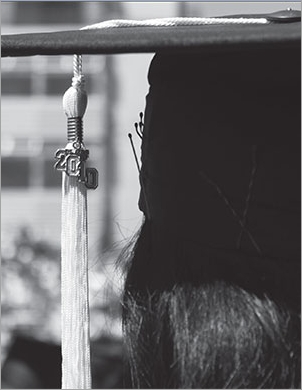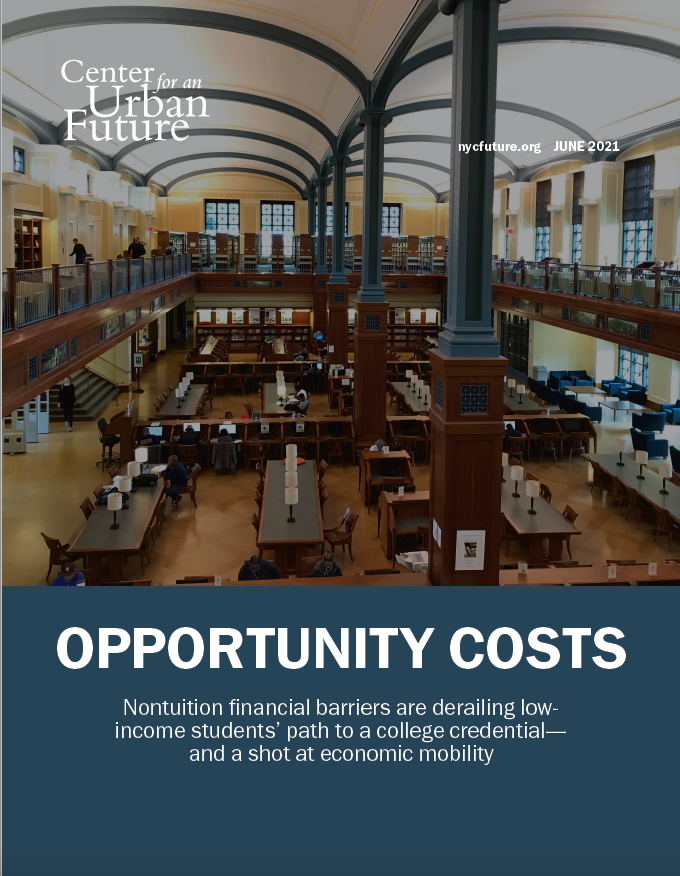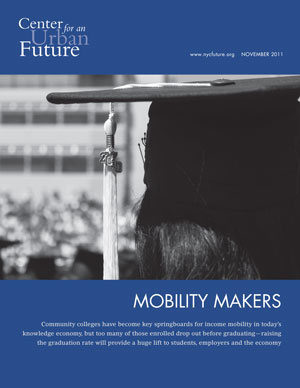Mayor de Blasio has made clear that tackling income inequality is his top policy priority and expansion of pre-kindergarten services his key policy response. Yet pre-kindergarten is not the only educational setting that boosts lifetime opportunities, screens out families that can’t afford high costs, and urgently demands mayoral attention. There are also the city’s community colleges.
Success in today’s knowledge economy increasingly requires a postsecondary credential, not just a high school diploma, and nowhere is that more the case than in a global metropolis like New York City. Indeed, the gap between high school graduates and college graduates is stark. The average New Yorker between the ages of 25 to 29 with no more than a high school diploma will earn a dismal $17,000. With an associate’s degree, income rises to $29,000 and with a bachelor’s degree to $42,000. The current unemployment rate for college graduates is 6 percent, compared to 10 percent for adults with only a high school diploma. The employment participation rate—the share of adults that are working—for New York City residents with an associate’s degree is 68 percent; in contrast, only about half of all city residents with a high school diploma or a year of college are employed at any given time.
While four-year colleges and universities generally open more doors than two-year institutions, community colleges arguably play an equal or greater role in elevating New Yorkers into the middle class.
At a time when a high school diploma is no longer sufficient to obtain a decent paying job in most industries but when the cost of getting a college education has skyrocketed, the city’s community colleges offer the most accessible path for tens of thousands of low- and moderate- income New Yorkers to obtain a post-secondary credential. Many of these individuals don’t have the grades, money, language skills or connections to attend a four-year institution. For others, four-year colleges simply don’t offer the flexibility they need to take classes while maintaining a full-time job to support themselves and their family.
More than 91,000 people currently study at the city’s community colleges, a population roughly the size of Santa Monica, CA. Almost half (46 percent) come from households with an income below $20,000, 48 percent are the first generation of their family to attend college, and 44 percent were born outside of the United States.
Strengthening community colleges can go a long way in helping to shrink income inequality and bring New York’s “Two Cities” closer together. It can boost the city’s economy and integrate its foreign-born immigrant community into the larger population. Importantly, New York City’s community colleges are poised for takeoff. Like community colleges around the country, they face major hurdles to achieve the best outcomes for students. Yet they differ from most of their counterparts in at least one striking way: CUNY has invested in creative strategies to improve those outcomes, along with the development of an evidence base to continuously improve them.
With a little help from Mayor de Blasio, the seven community colleges in the CUNY system could scale up interventions that have already been shown to work. The new administration could focus its efforts on flattening three roadblocks to student success: getting in, getting through, and getting a job.
Getting in: So many young people and adults fail to get the preparation and support they need to consider themselves “college material.” That should change. CUNY has partnered with the city Department of Education in the Graduate NYC! initiative to pave the road from high school to college through more effective curriculum alignment and dissemination of “college knowledge” to high school students. Private support from the Gates Foundation helped to get Graduate NYC! off the ground, but the grant expired in 2013. The city should step in to support Graduate NYC!, both financially and by thinking ambitiously about what a DOE/CUNY partnership can accomplish.
Adults also need improved access to college. DOE receives more than $30 million in state adult education and ESL funding, and could be doing much more to help its students achieve a postsecondary credential. For example, DOE could build partnerships with the community colleges to support the I-BEST (Integrated Basic Education and Skills Training) model, an innovative program that originated in Washington State which pairs adult literacy and vocational instruction in a single course, or the GED Pathway to Health and Business model, in which students learn about the skills tested on the GED exam (now the TASC exam) through content specific to their field of interest.
Getting through: Only 29 percent of students that enroll in one of the city’s community colleges graduate within six years. The fact that this low completion rate is typical of community colleges nationwide does not make it any more acceptable, especially given the well-documented benefits of graduation. Fortunately, CUNY has several promising initiatives ready to be scaled up. The most prominent of these, the Accelerated Study in Associate Programs, or ASAP, provides one-on-one counseling and a range of other support services to students in exchange for a commitment to study full-time. CUNY is about to scale up ASAP to 4,000 students citywide, but in a system with nearly 100,000 students, there is plenty of room for more aggressive growth.
Remedial education also drives the high student dropout rate. Underprepared students get bogged down in remedial classes, burning up precious time and financial aid eligibility. The CUNY Start initiative, which provides an intensive, low-cost alternative to traditional remedial education, has shown dramatic results in helping students achieve math, reading and writing proficiency.
Getting a job: Community college students need to obtain jobs in their fields after graduation so they can start careers and contribute to the city’s economy. Those months after graduation mark the intersection of higher ed and economic development. One highly effective approach is the career pathways framework, which alternates educational opportunities with employment in a connected and deliberate way. CUNY has launched the Career Path initiative at Kingsborough Community College with federal funding. Not only does Career Path deserve to be scaled up, it also would benefit from deeper coordination with city workforce, education and youth development agencies, which the de Blasio administration could expedite. The administration should also facilitate the expanded use of work-study programs with private-sector employers , and take advantage of newly available data on post-graduation employment to build bridges between community colleges, employers and the city’s workforce development system.
Mayor de Blasio clearly understands the connection between economic opportunity and the long game of educational opportunity. Starting with enhanced child care and pre-kindergarten and overhauling the city’s primary and secondary education system make sense – but reform should not end there. The new administration should support CUNY in scaling up the major reforms already showing results, while simultaneously holding community colleges accountable for improving the rate at which disadvantaged students enroll, graduate and get jobs in their fields. With commitment and patience, the new administration could make a huge difference in the economic opportunities available to New Yorkers already aspiring to a better life.





